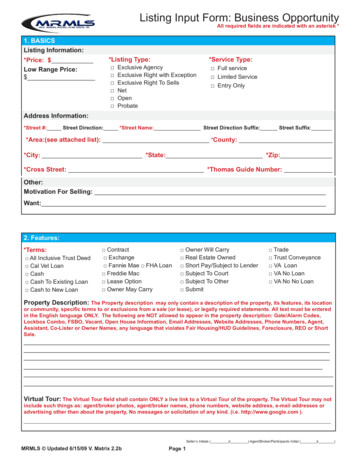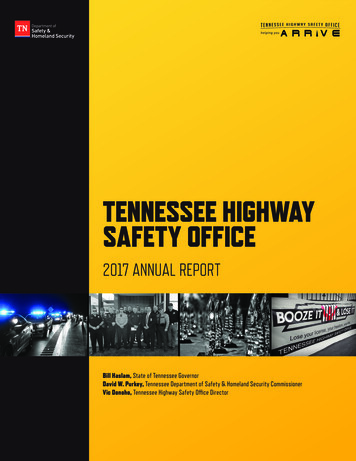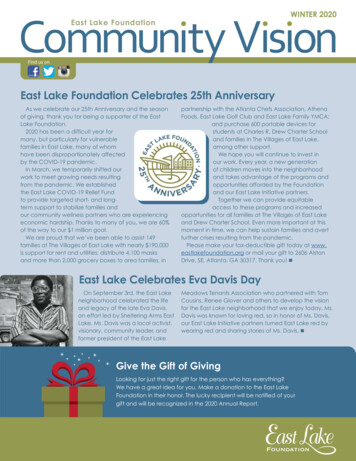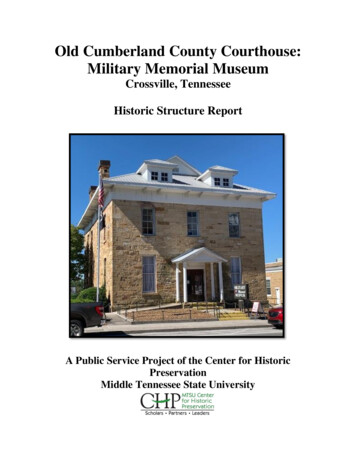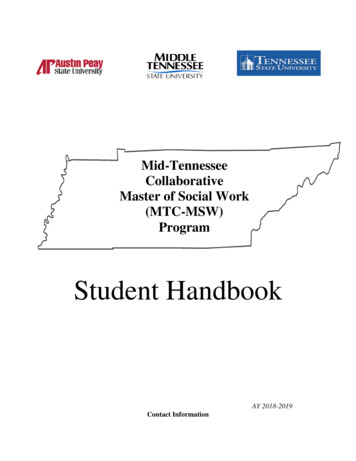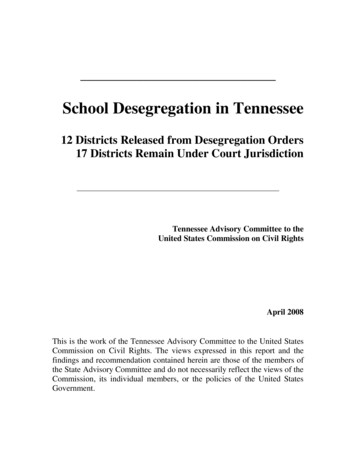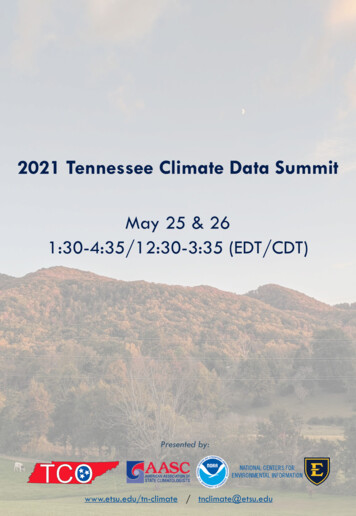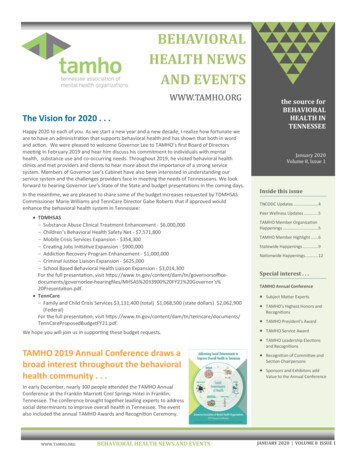
Transcription
ARBS 2018 PROCEEDINGS5th Annual ConferenceVolume IIIMarch 22-23, 2018East Tennessee State UniversityJohnson City, TNEdited by:Carolyn Rochelle and Prasun BhattacharjeeEast Tennessee State UniversityProceedings of the Appalachian Research in Business Symposium, East Tennessee State University, March 22-23, 20180
2018 Appalachian Research in Business SymposiumConference CommitteeCarolyn Rochelle, East Tennessee State University (Conference Co-Chair)Prasun Bhattacharjee, East Tennessee State University (Conference Co-Chair)Sandra Vannoy, Appalachian State UniversityKristen Brewer, Eastern Kentucky UniversitySteve Ha, Western Carolina UniversityIt is our pleasure to present the Proceedings of the 5th Annual Appalachian Research in BusinessSymposium from the 2018 conference held March 22-23, hosted by the College of Business andTechnology at East Tennessee State University. The Appalachian Research in BusinessSymposium provides a venue for presenting new research, discovering contemporary ideas, andbuilding connections among scholars at Appalachian State University, Eastern KentuckyUniversity, East Tennessee State University, and Western Carolina University.Acknowledgements:The Conference Committee for the 2018 Appalachian Research in Business Symposium wishesto extend our gratitude to the College of Business and Technology at East Tennessee StateUniversity for hosting this year’s event. Additionally, we would like to extend our appreciationto all of the participants and to those colleagues who contributed significant effort in service tothe conference.Keynote Speaker:Anthony “Tony” Keck, Executive VP System Transformation & Chief Population Health Officerat Ballad HealthWebsite, Registration and Events:Kristy BuchananLaura BenningtonLisa PierceTammy PetersonSession Chairs:Beichen LiangC. Allen GormanDana HarrisonGary BurketteGary ShelleyHeather L. MooreJill HayterKent SchneiderKurt LoessPrasun BhattacharjeeUmit SaglamProceedings of the Appalachian Research in Business Symposium, East Tennessee State University, March 22-23, 20181
Reviewers:Appalachian State UniversityEast Tennessee State UniversityBetty CoffeyBrandy HadleyDawn MedlinJacqui BergmanJoseph CazierKen WhiteC. Allen GormanCarolyn RochelleDana HarrisonJoseph NewhardLewis AlexanderSam K. FormbySandra VannoySteve LeonRegina DeLisse HartleyEastern Kentucky UniversityAllen EnglePhilip J. Boutin, Jr.Beth PolinQian XiaoKristen BrewerWeiling ZhuangLee AllisonMichael McKinneyPrasun BhattacharjeeUmit SaglamWilliam TrainorWestern Carolina UniversityJon MarvelScott RaderSteve HaWilliam RichmondProceedings Editors:Carolyn RochellePrasun BhattacharjeeProceedings of the Appalachian Research in Business Symposium, East Tennessee State University, March 22-23, 20182
Table of ContentsAnalysis of Agile Learning into Information Systems Project Class: A CognitiveApprenticeship Approach . 5Xiong, Jie, Appalachian State UniversityTang, Yong, University of Electronic Science and Technology of ChinaMedlin, Dawn B., Appalachian State UniversityBlocks for Bees: Solving Bee Business Problems with Blockchain Technology . 11Dobbins, Avery, Appalachian State UniversitySprinkle, Alisha, Appalachian State UniversityHadley, Brandy, Appalachian State UniversityCazier, Joseph, Appalachian State UniversityWilkes, James, Appalachian State UniversityBusiness Students’ Personal Branding: An Empirical Investigation . 17Allison, Lee, Eastern Kentucky UniversityBoutin, Jr., Philip J., Eastern Kentucky UniversityCumiskey, Kevin J., Eastern Kentucky UniversityEscalation of Commitment in New Product Evaluation: The Moderating Roles of GoalGradient and Subgoal Effect. 24Liang, Beichen, East Tennessee State UniversityEthical Hacking: Cybersecurity Education for the 21st Century . 30Medlin, B. Dawn, Appalachian State UniversityHartley, Regina D., Appalachian State UniversityFull Range Focus: How Regulatory Focus Influences the Relationship between LeaderBehavior and Subordinate Outcomes . 36Gorman, C. Allen, East Tennessee State UniversityChavez Reyes, Denise, East Tennessee State UniversityImpact of NOL Carryforwards: Subsidizing Startups . 43Beach, Robert, East Tennessee State UniversityOnboarding Freshman Business Students: Mindfulness, Learning, and a Business Plan forLife. 47Roberson, Michael, Eastern Kentucky UniversityReverse Logistics: Scenarios Related To Drone Deliveries and Returns. 54Fowler, Victoria, Appalachian State UniversityMedlin, Dawn B., Appalachian State UniversityVannoy, Sandra A., Appalachian State UniversitySocial Constructivism and Cooperative Learning in Marketing Courses: A Sample InClass Activity . 59Boutin, Jr., Philip J., Eastern Kentucky UniversityProceedings of the Appalachian Research in Business Symposium, East Tennessee State University, March 22-23, 20183
Table of Contents (Contd.)“Team Fracking” – The Unintended Consequences of Bullying Within Work Teams . 68Creasy, Todd, Western Carolina UniversityCarnes, Andrew, Western Carolina UniversityTechnology Transfer Policy Efficiency: The Influence of Diversity and Inclusion . 73Emery, Dan E., Appalachian State UniversityKing, Austin K., Appalachian State UniversityMeyer, Kolbert A., Appalachian State UniversityHadley, Brandy E., Appalachian State UniversityThe Moderating Effects of Salespersons’ Behaviors on Supplier Integration for NewProduct Development . 85Oh, Jae-Young, Eastern Kentucky UniversityYour Learning Style May Explain Your Emotional Intelligence or Your EmotionalIneptitude . 92Moore, T. Winters, East Tennessee State UniversityProceedings of the Appalachian Research in Business Symposium, East Tennessee State University, March 22-23, 20184
Analysis of Agile Learning into Information Systems Project Class:A Cognitive Apprenticeship ApproachXiong, JieCIS & SCM DepartmentWalker College of BusinessAppalachian State UniversityBoone, NC 28608 USAxiongjj@appstate.edu (Contact Author)Tang, YongSchool of Computer Science and EngineeringUniversity of Electronic Science and Technology of ChinaChengdu, Sichuan, Chinatangyong@ueste.edu.cnMedlin, Dawn B.CIS & SCM DepartmentWalker College of BusinessAppalachian State UniversityBoone, NC 28608 USAmedlinbd@appstate.eduKey words: Agile Development, Cognitive Apprenticeship, Information Systems Project,Pedagogical ApproachesIntroductionAgile methods, also known as agile software development methods, are considered as one of themost popular ways of delivering software projects through collaborative teamwork to clients. Thepast few years have witnessed a significant adoption of agile software development withindifferent industries (Beck, 1999; Cockburn, 2006; Cockburn & Highsmith, 2001; Dingsøyr, Nerur,Balijepally, & Moe, 2012; Dybå & Dingsøyr, 2008; Kruchten, 2013a; J. Sharp & Ryan, 2011).Suitable for various software project scenarios with increasing project uncertainties and changes,agile methodologies vary in different development approaches from iterative to incremental,differentiation cycles from days to weeks, team sizes of small to large, ways of documentation,and varying degrees of customer involvements. Centralized on people, agile methodologiesemphasize interactions, workable systems, customer collaboration, and response to changes ( Becket al., 2001). Among these agile methods, Extreme Programming (XP) (Beck, 1999; Beck &Proceedings of the Appalachian Research in Business Symposium, East Tennessee State University, March 22-23, 20185
Fowler, 2001) and Scrum (Schwaber & Beedle, 2002) have become the most two popularapproaches.However, very little is known about the learning process and outcomes students majoring inComputer Information Systems (CIS) are being afforded in this field of study. This researchutilizes Cognitive Apprenticeship as theoretical to investigate and access the learning process andtheir outcomes. Cognitive Apprenticeship is a constructivism theory that suggests that studentslearn from each other through modeling, coaching, scaffolding, articulation, reflection, andexploration (Collins, Brown, & Newman, 2007). The role of agile learning is investigated in thepaper. Overall, the research question of the paper isWhat’s the role of agile learning process in Information System Project classes?Theoretical BackgroundAgile methodologies bring changes and impacts on various aspects of software development likebusiness innovation (Highsmith & Cockburn, 2001), the people factors (Cockburn & Highsmith,2001), the ecosystems (Highsmith, 2002), the principles, patterns, and practices (Martin, 2002),and planning (Beck & Fowler, 2001). All of these expectations can be overwhelming for traditionalschool education. A gap between industry expectations and academic education related to agilemethodologies is under criticism (Fox & Patterson, 2012). Due to limited course time, it is unlikelythat all aspects of agile methods can be covered. However, important concepts and values of atleast one agile method, XP or Scrum, such as the iterative development, incremental delivery,team-customer interaction driven R&D, continuous integration, and team management etc., arenecessary to equip the students with appropriate knowledge in order to be successful in themarketplace. Tan et. al. has suggested that a course on agile should include four factors: teambased guidance, stress on working and integrated software solution, value of progressive andflexible methods, being adaptive to changing requirements (Tan et al., 2008). Agile methods arealso taught in advanced capstone courses on enterprise software development which are morecomplicated in used technologies, project scales, and project management. A communicationchannel and getting stakeholders onboard is crucial for a semester-long project to deliver workableproducts (Iyengar, 2009). The agile concepts and methods are the fundamentals for agile softwaredevelopment activities, among which teamwork and customer collaboration are the most importantissues in teaching and practicing (Rico & Sayani, 2009).Also, in the design of pedagogy and curriculum for agile methodologies teaching must considerthe student perceptions (Melnik & Maurer, 2005). In their case study of a software engineeringcourse with focus on pairing programming and agile methods, a collaborative pedagogyintervention on student perception is studied and verified a social interaction model of studentviews (Slaten et al., 2005). Since the teamwork of agile software development emphasizesinteractions within the team and with the customers, the full agile project cycle in lab courses canbenefit students in developing technical skills as well as inter-personal social skills (Schwaber,2004). These repeated practices of applying agile methods in software development projectscourses are essential for students to form a habit and thinking of agile values and practices, throughwhich students can turn to be skilled engineers in the long run. Also this kind of agile methodseducation can be called sustainable (Martin Kropp & Meier, 2014).Proceedings of the Appalachian Research in Business Symposium, East Tennessee State University, March 22-23, 20186
Research Methodology and Data CollectionThe research adopts a collective case study approach (Benbasat, Goldstein, & Mead, 1987) toinvestigate the learning outcomes as well as the learning process. Cognitive apprenticeship isutilized as the theoretical lens to further identify key processes that are important in studentlearning.Client InformationStudents’ReflectionsProject wassuccessfulManage membershipinformation, event attendanceinformation, andaccounting/financialinformationHelp offer local breweriesinformationThe new systemgrants 24/7 accessto all neededinformationMethodologyStudent ClubInformationSystems for AITPmembersWaterfallStartup that reviewslocal pMakrSwatching companyMobileInformationSystemsPrototypingiPad, Gmail.Reduce cost and enhanceproductivityWomen’s RugbyteamOnline PaymentSystemsAgile/ScrumCookie CompanyOnline MobileOrdering SystemsWaterfallEnables client to easily andefficiently collect dues fromteam membersImproves the customer's onlineshopping experienceCosmic KarmaWebsiteRapid-applicationdevelopmentWix, Square(POS), GoogleDocsHTML5,Google Docs,PHP, MySQLGoogle webdeveloper tool,WixAdvancedRadiologyPeer reviewsystem forradiologistsAgile/ScrumLocal small businessWebsiteMBA fallUniversity TechSupportOnlineInformationSystemsLocal Flower ShopWebsiteA pre-clinical stagepharmaceuticalcompanyData Storage andAnalytics ITSystemCenter forEntrepreneurshipAgileWaterfall/ ngTypes of ITUtilizedDrupal 7GooglecomputingenvironmentDraw.io,MicrosoftVisual Studio,C#Outcomes and SustainableDevelopmentMaintenance free afterimplementation, easy to useProjectDescriptionDatabase forvolunteersHTML5,CSS3,JavaScript,PHP7, andSQL.HTML, CSS,PHP.MySQLWorkbenchand VisualStudioHTML5,Bootstrap3,JavaScript,Druple, CSSSquareSpaceSQL, C#,HTML/CSSExcellent project toundertake within asemester and avaluable learningexperienceIncreasesustainability byeliminating paperbasedcommunicationHelps sports teamHelps local smallbusinessEnhances product sales,marketing, companycredibility/image and longterm equityDecreases Operational Cost,Decreases Malpractice CostsSupports local smallbusinessAllows better communicationwith potential clientsIncreased time efficient andsecuritySupports local smallbusinessSupports theuniversityProvides increased workperformance, employeesatisfaction, accountabilityReduce paper basedapplication,increasessustainabilitySupports local smallbusinessSupports local smallbusinessIncreases long-term customersatisfactionsSignificant cut down in paperusedIncreases ClientSatisfactionTable 1. Students Project SummaryProceedings of the Appalachian Research in Business Symposium, East Tennessee State University, March 22-23, 20187
Data Analysis and ResultsData was collected in two regular semesters in 2017. Overall, there are 13 cases included in theanalysis. Detailed information can be found in Table 1.Based on the cases, Coaching, Scaffolding, and Reflection are identified as the key frames thatsupport the agile learning process within this study. Coaching includes feedback offering and taskperformance evaluation from the instructors. Based on the data, all 13 cases involve certaincoaching from the instructors as well as from the students. For example, some students in the grouphave better knowledge in programming, while others have more advanced experiences in projectmanagement. Agile learning in a group setting provides students a learning environment thatsupport active learning. Scaffolding in the frame suggests that agile learning is supported by themethods as well as strategies that are designed early. Finally, reflection throughout the twosemesters from students and clients further offer opportunities for students to look back andchallenge them to address future problem-solving processes.ConclusionsIn this paper, we apply cognitive apprenticeship theory into an IS project class in order to analyzethe agile methodology learning process of students, as well as further understand how students cananalyze, design, create, and implement an IS project for clients within the local community tosupport their sustainable development. Through the collective case study method, 13 cases areanalyzed. More detailed analysis is needed for future research.ReferencesBeck, K. (1999). Embracing change with extreme programming. Computer, 32(10), 70–77.https://doi.org/10.1109/2.796139Beck, K., Beedle, M., van Bennekum, A., Cockburn, A., Cunningham, W., Fowler, M., Thomas,D. (2001). Manifesto for Agile Software Development. Manifesto for Agile Software Development.Retrieved from http://www.agilemanifesto.org/Beck, K., & Fowler, M. (2001). Planning extreme programming. Addison-Wesley Professional.Benbasat, I., Goldstein, D. K., & Mead, M. (1987). The Case Research Strategy in Studies ofInformation Systems. MIS Quarterly, 11(3), 369. https://doi.org/10.2307/248684Cockburn, A. (2006). Agile software development: the cooperative game. Pearson Education.Cockburn, A., & Highsmith, J. (2001). Agile software development, the people factor. Computer,34(11), 131–133. https://doi.org/10.1109/2.963450Cockburn, A., & Highsmith, J. (2001). Agile software development: The people factor. Computer,34(11), 131–133. https://doi.org/10.1109/2.963450Proceedings of the Appalachian Research in Business Symposium, East Tennessee State University, March 22-23, 20188
Collins, A., Brown, J. S., & Newman, S. E. (2007). Cognitive Apprenticeship: Teaching the craftof reading, writing and mathematics. Knowing Learning and Instruction, 8(1), 453–494.https://doi.org/[BBB14200], [MGG06460]Dingsøyr, T., Nerur, S., Balijepally, V., & Moe, N. B. (2012). A decade of agile methodologies:Towards explaining agile software development. Journal of Systems and Software, 85(6), 1213–1221. 12.02.033Dybå, T., & Dingsøyr, T. (2008). Empirical studies of agile software development: A systematic review.Information and Software Technology, 50(9–10), 833–859. https://doi.org/10.1016/j.infsof.2008.01.006Fox, A., & Patterson, D. (2012). Crossing the software education chasm. Communications of theACM, 55(5), 44. https://doi.org/10.1145/2160718.2160732Highsmith, J. (2002). Agile Software Development Ecosystems. Boston, MA, USA: AddisonWesley Longman Publishing Co., Inc.Highsmith, J., & Cockburn, A. (2001). Agile software development: the business of innovation.Computer, 34(9), 120–127. https://doi.org/10.1109/2.947100Iyengar, S. R. (2009). Teaching Enterprise Software Development in Undergraduate Curriculum.In Proceedings of the 10th ACM Conference on SIG-information Technology Education (pp. 29–32). New York, NY, USA: ACM. https://doi.org/10.1145/1631728.1631739Kropp, M., & Meier, A. (2013). Teaching agile software development at university level: Values,management, and craftsmanship. In 2013 26th International Conference on Software EngineeringEducation and Training (CSEE T) (pp. 179–188). https://doi.org/10.1109/CSEET.2013.6595249Kropp, M., & Meier, A. (2014). New sustainable teaching approaches in software engineeringeducation: How agile methods influence teaching software engineering. IEEE Global EngineeringEducation Conference, EDUCON, (April), 1019–1022. n, P. (2013a). Contextualizing agile software development. Journal of Software: Evolution& Process, 25(4), 351–361. https://doi.org/10.1002/smr.572Kruchten, P. (2013b). Contextualizing agile software development. Journal of Software: Evolution& Process, 25(4), 351–361. https://doi.org/10.1002/smr.572Martin, R. C. (2002). Agile software development: principles, patterns, and practices. PrenticeHall.Melnik, G., & Maurer, F. (2005). A cross-program investigation of students’ perceptions of agilemethods. In Proceedings. 27th International Conference on Software Engineering, 2005. ICSE2005. (pp. 481–488). https://doi.org/10.1109/ICSE.2005.1553593Rico, D. F., & Sayani, H. H. (2009). Use of Agile Methods in Software Engineering Education. In2009 Agile Conference (pp. 174–179). https://doi.org/10.1109/AGILE.2009.13Proceedings of the Appalachian Research in Business Symposium, East Tennessee State University, March 22-23, 20189
Schwaber, K. (2004). Agile Project Management With Scrum. Redmond, WA, USA: MicrosoftPress.Schwaber, K., & Beedle, M. (2002). Agile software development with Scrum. Prentice Hall UpperSaddle River.Sharp, J. H., Ryan, S. D., & Prybutok, V. R. (2014). Global Agile Team Design : An InformingScience Perspective, 17, 175–187.Sharp, J., & Ryan, S. (2011). Best Practices for Configuring Globally Distributed Agile Teams.Journal of Information Technology Management, XXII(4), 56–63. Retrieved from http://jitm.ubalt.edu/XXII4/article4.pdfSlaten, K. M., Droujkova, M., Berenson, S. B., Williams, L., & Layman, L. (2005). Undergraduatestudent perceptions of pair programming and agile software methodologies: verifying a model ofsocial interaction. In Agile Development Conference (ADC’05) (pp. 323–330). https://doi.org/10.1109/ADC.2005.48Tan, C.-H., Tan, W.-K., & Teo, H.-H. (2008). Training Students to Be Agile Information SystemsDevelopers: A Pedagogical Approach. In Proceedings of the 2008 ACM SIGMIS CPR Conferenceon Computer Personnel Doctoral Consortium and Research (pp. 88–96). New York, NY, USA:ACM. https://doi.org/10.1145/1355238.1355259Proceedings of the Appalachian Research in Business Symposium, East Tennessee State University, March 22-23, 201810
Blocks for Bees: Solving Bee Business Problems with BlockchainTechnologyDobbins, Averydobbinsal@appstate.eduSprinkle, Alishasprinkleam@appstate.eduHadley, Brandyhadleybe@appstate.eduCazier, Josephcazierja@appstate.eduWilkes, Jameswilkesjt@appstate.eduCenter for Analytics Research and EducationWalker College of BusinessAppalachian State University416 Howard StreetBoone, NC 28607-2037Key words: Blockchain, bees, honey, pollination, smart contractsIntroductionThis paper will discuss the role that distributed ledger technology, more commonly referred to asBlockchain Technology, can serve in alleviating some of the business problems faced bycommercial beekeepers. Specifically we will illustrate how blockchain can be used to reducehoney adulteration, develop smart pollination contracts, and improve the apiary insurance market.By collecting repeated electronic measurements of hive characteristics and performance, accuratemodels of production can be created for both individual hives and apiaries or larger demographiccategories. Importantly, by utilizing the cryptographically secure nature of blockchain to storeaccurate and distinguishable data about individual beehives, which can later be audited to ensurecharacteristic validity, it is possible to remove many of the information asymmetries which existin markets related to beekeeping.Proceedings of the Appalachian Research in Business Symposium, East Tennessee State University, March 22-23, 201811
Literature ReviewWhen thinking of blockchain, most think of Bitcoin and cryptocurrency. This is the most popularuse of the blockchain due to its secure nature and anonymous transactions (Nakamoto, 2008).However, blockchain can be utilized as a public ledger through a decentralized trustless systemwith much broader applications than as a currency (Swan, 2015). Blockchain has beendemonstrated as a useful tool for agricultural product tracking (Kim & Laskowski, 2017),streamlining and protecting global supply chains (Kumar & Iyengar, 2017), and safeguarding theanonymity and collectivity of client records in the healthcare industry (Ekblaw, Azaria, Halamka,& Lippman, 2016). Blockchain can also be used to create and govern “smart contracts” in an openand transparent form for all parties involved. Utilizing the open ledger nature of the technology,temporary worker contracting has previously been explored, revealing a potential to eliminateexternal oversight conditions in agreements (Pinna & Ibba, 2017).The Value in BlockchainIn order to capture the benefits of blockchain technology, data must first be collected from hives.Currently a large majority of beekeepers keep paper records and utilize largely qualitativemeasures of performance and health such as estimations of honeybee cluster size or space availablefor new comb to be drawn. In addition to these measures, by collecting quantitative electronicvariables, it is possible to build a much more complete picture of a hive’s overall condition.Through the measurement of well defined criteria, it is possible to perform much more accurateand meaningful analysis. By installing a suite of affordable and simple measuring devices, data ontemperature and humidity within the hive, as well as location, elevation, weight, and time of daycan be aggregated and sent to cloud storage for automatic analysis. From here the production datacan be used to elicit characteristics about quantity of honey produced, pollination activities, as wellas hive health and physical conditions. Finally the sourced data along with the statisticalelicitations can be recorded in a blockchain which explicitly ties the measurements to the specifichive of origin. The field of agriculture has already seen blockchain implemented. In China,chickens are traceable on a blockchain through a company called Gogochicken. This traceabilitysecurity that blockchain provides can extend to beekeepers and honey suppliers as well.At a fundamental level, blockchain is data you can trust. Data is bound to a strict framework usingcryptography and hashing algorithms to create a database, or chain, based on a precedingtransaction. This means that it is mathematically impossible to change data once it has been setwithout evident tampering, thus providing data integrity. You can confirm that your data is true asof the time it was recorded dating back to the first transaction that occurred. Because this data isstored in the cloud, it can be analyzed by researchers to better predict future outcomes and trends.Potential ImplicationsHoney AdulterationHoney Adulteration is the practice of diluting otherwise pure honey with other syrups in an effortto produce higher volumes of product at lower costs with less volatility. US apiaries produced anProceedings of the Appalachian Research in Business Symposium, East Tennessee State University, March 22-23, 201812
estimated 149 million pounds of honey in 2013. However US consumption of honey was over 410million pounds; more than twice as much (US Honey Industry Report 2015, Bee CultureMagazine). This illustrates the large existing demand which has been increasing the price of honeysteadily over the last decade. This high demand coupled with the recent decline in bee populations(Ellis, Evans, & Pettis, 2010) and the difficult nature of distinguishing pure honey from adulteratedproducts has led to large incentives for producers and suppliers to dilute their honey products,providing unknowing consumers with lower quality goods. This is particularly troubling becauseby artificially raising the quantity of honey at market, the valuation of pure honey is depressedbelow its otherwise equilibrium price. This makes it difficult for beekeeping to be profitable andmakes the recently increasing mortality rate of bees even more devastating.Blockchain solutions to this problem are promising however. By tying the data about weight beforeand after honey collection to each specific jar or container of honey produced it becomes possiblefor consumers and finished goods producers to easily determine the honey they purchase is genuineby referencing the data stored in a blockchain. Further, this process allows for consumers to knowexactly which apiary their honey was harvested from and allows for specialization within themarket such as mānuka honey which can originate only in areas indigenous to the mānuka tree(Russell, Molan, Wilkins, & Holland, 1990). This leveling of information asymmetries effectivelyallows beekeepers to separate the market for pure honey from the market of honey which may beadulterated. Since we can assume that pure honey is preferable in all cases where one would usepossibly adulterated honey we can safely say that this would raise the price of pure honey,increasing price efficiency and largely mitigating the depressive effects adulteration has on honeyprices.Smart ContractingBlockchain also has implications in the US pollination market, which is dominated by bees andbeekeepers, where more than 410 million is reported as pollination income yearly (USDA, 2017).Bees are integral in the production process of the large majority of all fruits, vegetables, and nutssold to consumers (Morse & Calderone, 2000). However, current pollination contracts often leavehives open to dangers such as pesticides from adjacent fields and physical damage from farmequipment, leaving little recourse for beekeepers who are taking on these risks. A smart contractis a piece of code which is stored in the blockchain network. It defines the conditions to which allparties using a contract agree. If all required conditions are met, certain predefined actions, suchas payment for a service, follows automatically. Adopting blockchain open ledger technologywould allow both beekeepers and farmers to be aware of when bees are performing and contractobligations are being fulfilled, creating evidence based payment criteria. This would also greatlyfurther the use of pay for performance type contracting conditions. By using encrypted data toreveal differences in pollination activity, both beekeepers and farmers would be able to moreaccurately attribute results to the work done by individual beehives, with certainty in the recordeddata, and charge for them accordingly. The data collection behind block
JavaScript, PHP7, and SQL. Decreases Operational Cost, Decreases Malpractice Costs Increases Client Satisfaction Local small business Website Combined Waterfall/Agile HTML, CSS, PHP. Allows better communication with potential clients Supports local small business MBA Graduate Office Database Waterfall MySQL Workbench and Visual Studio

